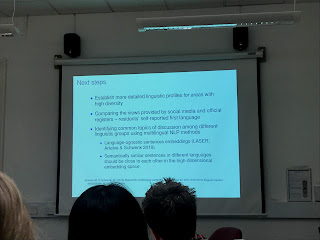Mapping the linguistic landscape of Helsinki, Finland using social media data
Social media and digital footprints in urban space at Pearson building , Department of geography UCL dated 11th April 2019
 Physical and virtual spaces - satellite positioning technology and location information connect. The resulting ‘double space’ also encompasses the physical data. The tracking temporal changes has been closed via instagram API uploaded on Instagram between July 2013- Feb 2018. Instagram aggregate all the place name in different direction. The API allows to POI_ points of interests on the platform. The graph shows the tourist and public event is seen on the data and pattern is created yearly for 2018. The growing number in unique users is seen with lot of data to detect the automatic language identification. There is lots of variation in standard forms. There are three different algorithm developed by Google for the browser, CLD2 and fastText are the libraries with Landig.py. Evaluating using the gold standard that is Krippendorff’s alpha - 0.929. The results improves if its characteristics is changed to get good accuracy. It is interesting but not surprising is that facebook have created good algorithm to read different language which have linguistic meanings. Measuring and quantifying the linguistic language with its diversity developed in ecology and information science. Temporal changes in the virtual linguistic landscape which have third order polynomial regression. Japanese and Korean has increased with Swedish being the second official language where English being first language. Dominance or the proportion of the dominant language is decreasing with Shannon entropy used to describe the language kind of thinking which is very interesting. Unique languages in the metropolitan area
Physical and virtual spaces - satellite positioning technology and location information connect. The resulting ‘double space’ also encompasses the physical data. The tracking temporal changes has been closed via instagram API uploaded on Instagram between July 2013- Feb 2018. Instagram aggregate all the place name in different direction. The API allows to POI_ points of interests on the platform. The graph shows the tourist and public event is seen on the data and pattern is created yearly for 2018. The growing number in unique users is seen with lot of data to detect the automatic language identification. There is lots of variation in standard forms. There are three different algorithm developed by Google for the browser, CLD2 and fastText are the libraries with Landig.py. Evaluating using the gold standard that is Krippendorff’s alpha - 0.929. The results improves if its characteristics is changed to get good accuracy. It is interesting but not surprising is that facebook have created good algorithm to read different language which have linguistic meanings. Measuring and quantifying the linguistic language with its diversity developed in ecology and information science. Temporal changes in the virtual linguistic landscape which have third order polynomial regression. Japanese and Korean has increased with Swedish being the second official language where English being first language. Dominance or the proportion of the dominant language is decreasing with Shannon entropy used to describe the language kind of thinking which is very interesting. Unique languages in the metropolitan area 


Comments
Post a Comment